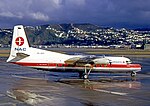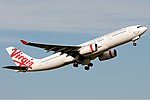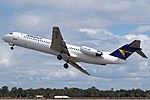User:Bahnfrend/sandbox
| 96 | |||||
|---|---|---|---|---|---|
| East Brunswick – St Kilda Beach | |||||
 | |||||
| Overview | |||||
| System | Melbourne tramway network | ||||
| Operator | Yarra Trams | ||||
| Depot | Southbank | ||||
| Vehicle | C2 class, D2 class | ||||
| Route | |||||
| Locale | Melbourne, Australia | ||||
| Start | East Brunswick | ||||
| Via | Bourke Street | ||||
| End | St. Kilda Beach | ||||
| Length | 13.9 km (8.6 mi) | ||||
| Timetable | Route 96 timetable | ||||
| Map | Route 96 map | ||||
| |||||

This is a list of aircraft operated by Air New Zealand, formerly Tasman Empire Airways Limited (TEAL). The list is intended to include all aircraft owned by or leased to the main airline or its regional subsidiaries Air Nelson, Eagle Airways, Mount Cook Airline (which operate additional short-haul New Zealand domestic services), or its former subsidiary Freedom Air.
Based in Auckland, New Zealand, the airline originated in 1940 as TEAL, a flying boat company operating trans-Tasman flights between New Zealand and Australia. In 1965, TEAL became wholly owned by the New Zealand government, whereupon it was renamed Air New Zealand. As of December 2012[update], the airline served 53 cities in 16 countries, including 27 destinations within New Zealand.[1]
Air New Zealand operates a long-haul fleet consisting of Boeing 747, Boeing 767, Boeing 777 and Airbus A320 aircraft on international routes. The carrier also utilises a fleet of Airbus A320 and Boeing 737 airliners for short-haul operations. Its regional subsidiaries operate ATR 72-500, Bombardier Q300 and Beech 1900D aircraft. As of December 2012[update], a total of 102 aircraft were operated by the group as a whole.[1]
Aircraft[edit]
The list includes the manufacturer, model, the total quantity operated by Air New Zealand (the peak quantity may be lower), the current quantity operated as of December 2012[update], the number of passengers (pax), and the years the first aircraft entered (start) and last aircraft retired (end) from service.
| Aircraft | Image | Quantity | Current | Pax | Start | End | Notes | Ref(s). |
|---|---|---|---|---|---|---|---|---|
| Short S.30 Empire Class |  |
2 | 0 | ? | 1940 | 1947 | TEAL was launched in 1940, with two Short S.30 Empire Class flying boats. | |
| Short S.25 Sandringham Mk IV 'Tasman Class' |  |
4 | 0 | ? | 1946 | 1949 | In 1946, TEAL acquired four Short S.25 Sandringham IV 'Tasman Class' flying boats. They suffered from engine cooling issues and were soon disposed of. The former ZK-AMH is now preserved (as VH-BRC) at Solent Sky museum in Southampton, Hampshire, UK | |
| Consolidated Boeing P2B-1 Catalina |  |
2 | 0 | ? | 1947 | 1949 | TEAL flew two Boeing-built Consolidated P2B-1 Catalinas from 1947 until 1949. They were loaned from the RNZAF and used as training and survey aircraft. | |
| Douglas DC-4 | - | ? | 0 | ? | 1948 | 1948 | The Short Sandringhams were grounded for six months in 1948 due to their engine cooling issues. During that period, TEAL chartered DC-4s from Trans Australia Airlines to operate its trans Tasman services. | |
| Short S.45 Solent Mk IV |  |
4 | 0 | ? | 1949 | 1960 | TEAL replaced the S.25s with four Short S.45 Solent Mk IVs, which were delivered in 1949. Three were withdrawn in 1954. The last one, ZK-AMO Aranui, served until 1960, and is now preserved at MOTAT. | |
| Douglas DC-6 |  |
3 | 0 | ? | 1954 | 1961 | In 1954, TEAL received three Douglas DC-6s upon the breakup of British Commonwealth Pacific Airlines. They were upgraded in 1956, and transferred to the RNZAF in 1961. | |
| Lockheed L-188 Electra |  |
5 | 0 | ? | 1959 | 1972 | The last new type to be operated by TEAL was the Lockheed L-188 Electra. Three were acquired new in 1959, but one crashed in 1965 and was replaced by a second-hand Electra purchased from Qantas. Another ex-Qantas Electra joined the fleet in 1971. The Electras were sold by 1972. | |
| Douglas DC-8-52 |  |
7 | 0 | ? | 1965 | 1981 | TEAL was renamed Air New Zealand in 1965, to coincide with the introduction of its first jetliner type, the Douglas DC-8-52. In the same year, the DC-8s started operating the company's first trans Pacific services, to Honolulu and Los Angeles. | |
| McDonnell Douglas DC-10 |  |
8 | 0 | ? | 1973 | 1982 | In 1973, Air New Zealand acquired its first widebodied type, the McDonnell Douglas DC-10. Following the DC-10 groundings and the Erebus disaster in 1979, they were quickly replaced by Boeing 747-200s. | |
| Fokker F-27-100 |  |
13 | 0 | 30 | 1978 | 1990? | Fokker F-27-100 | |
| Fokker F-27-500 |  |
? | 0 | ? | 1978 | 1990? | Fokker F-27-500 | |
| Boeing 737-200 |  |
24 | 0 | 120 | 1978 | 2001 | 737-200 | |
| Boeing 747-100 |  |
1 | 0 | ? | 1979 | 1979 | During the DC-10 groundings in 1979, Air New Zealand chartered a Boeing 747-100 from Pan Am to operate some of its trans Pacific services. | |
| Boeing 747-200 |  |
6 | 0 | ? | 1981 | 2000 | 747-200. | |
| Boeing 747-400 |  |
5 | 0 | 379 | 1989 | 2014 | 747-400. | [2] |
| Boeing 737-300 | – | 1 | 0 | 120 | 2001 | 2004 | Virgin Blue's sole 737-300, originally delivered to British Midland Airways in 1990, was acquired from Ansett Australia in 2001 to supplement the company's existing fleet of 737-400s. The aircraft flew in an unusual, mostly white livery. | [3] |
| Boeing 737-700 |  |
28 | 4 | 128 | 2001 | present | In the 2000s, Virgin Blue had a substantial fleet of 737-700s, but the -700 type is now gradually being replaced by other types. | [4] |
| Boeing 737–800 |  |
128 | 57+1[5] | 176 | 2001 | present | Since its introduction in 2001, the 737–800 type has formed the backbone of the Virgin Blue/Virgin Australia fleet. | [4] |
| Embraer E-170 |  |
6 | 0 | 80 | 2007 | 2012 | In 2006, Virgin Blue ordered 20 Embraer E-Jets The order included three E-170s, and six options, three of which were later converted into orders for E-170s. However, the E-170s were quickly replaced by more efficient ATR 72s. | [6][7][8] |
| Embraer E-190 |  |
18 | 16+2[9] | 104/98 | 2008 | present | The 2006 E-Jet order included 11 firm orders for E-190s, and three of the six options in that order were later converted into orders for that type. In 2008, Virgin Blue ordered another four E-190s, bringing the total to 18. | [4][6][7] |
| Boeing 777-300ER |  |
5 | 5 | 361 | 2009 | present | In 2007, six new 777-300ERs were ordered from Boeing to operate international services. Pending their delivery, one 777-300ER was leased from ILFC from 2009. Only four of the aircraft ordered in 2007 have since entered service. | [4][10][11] |
| Airbus A330-200 |  |
5 | 5 | 278/279 | 2010 | present | The A330-200s were acquired to replace the 737s on flights between Perth and Sydney / Melbourne. The first two were ex-Emirates aircraft; the others were ordered new from Airbus. | [4][12] |
| ATR 72-500 |  |
6 | 6 | 68 | 2011 | present | In 2011, Virgin Blue entered into an alliance with Skywest Airlines involving the wet leasing of up to 18 ATR 72s for use on regional services. The first four of these aircraft replaced the Embraer E-170s, and the first six of them are ATR 72-500s. | [13][8][14] |
| ATR 72-600 | - | 3 | 3 | 68 | 2012 | present | Of the ATR 72s wet-leased from Skywest Airlines, all but the first six are, or are to be, ATR 72-600s. | [13] |
| Fokker F100 |  |
2 | 2 | 100 | 2012 | 2013 | In February 2012, Virgin Australia announced that it had wet-leased two Fokker F100 aircraft (similar to the one pictured) from Alliance Airlines for one year to operate regional services. | [15] |
See also[edit]
- Air New Zealand destinations
- Air transport in New Zealand
- Ansett Australia
- List of airports in New Zealand
References[edit]
Footnotes[edit]
- ^ a b "Air New Zealand: Facts & Figures". Star Alliance website. Star Alliance. Retrieved 22 December 2012.
{{cite web}}: External link in|work= - ^ Anthony, John (12 September 2014). "Last Air New Zealand Boeing 747-400 takes final flight". The Sydney Morning Herald. Retrieved 12 September 2014.
- ^ "Boeing 737 - MSN 24461 - UR-VVI". Airfleets.net. Airfleets.net. Retrieved 17 December 2012.
{{cite web}}: External link in|work= - ^ a b c d e Cite error: The named reference
atdb vawas invoked but never defined (see the help page). - ^ One of the 737-800s is leased out.
- ^ a b "Virgin Blue Orders 20 Embraer". Virgin Australia website. Virgin Australia. 2 November 2006. Retrieved 19 December 2012.
{{cite web}}: External link in|work= - ^ a b "Australian airline's firm orders now total 24 aircraft". [http://www.virginaustralia.com/au/ Virgin Australia website. Virgin Australia. 2 February 2008. Retrieved 19 December 2012.
{{cite web}}: External link in|work= - ^ a b Creedy, Steve (4 March 2011). "Australia now on radar for turboprop manufacturer ATR". The Australian. Retrieved 18 December 2012.
{{cite news}}: External link in|newspaper= - ^ Two E-190s are leased out.
- ^ "Virgin Blue Orders Boeing 777-300ERs to Initiate Long-Haul Service". Boeing Company website. Boeing Company. 21 March 2007. Retrieved 19 December 2012.
{{cite web}}: External link in|work= - ^ "First Australian Boeing 777 goes to V Australia". Boeing Company website. Boeing Company. 6 February 2009. Retrieved 19 December 2012.
{{cite web}}: External link in|work= - ^ "A330s, Etihad alliance for Virgin Blue as profit meets expectations". Australian Aviation website. Australian Aviation. 26 August 2010. Retrieved 19 December 2012.
{{cite web}}: External link in|work= - ^ a b Cite error: The named reference
avairwas invoked but never defined (see the help page). - ^ "Five more ATR 72s for Virgin Australia". Australian Aviation. 14 December 2011. Retrieved 18 December 2012.
{{cite news}}: External link in|newspaper= - ^ Cite error: The named reference
ch-aviationwas invoked but never defined (see the help page).
Bibliography[edit]
- Harrison, Brian; Lockstone, Brian (2000). A Century of Aviation in New Zealand. Wellington: Grantham House Publishing. ISBN 9781869340780.
- Lowe, David (1981). Air New Zealand: the international aircraft from flying-boats to the 747. Auckland: Lodestar Press. ISBN 0864650086.
- Sheehan, Paul (2003). The Aircraft of Air New Zealand and affiliates since 1940. Wellington: transpress. ISBN 0-908876-24-6.
External links[edit]
- Air New Zealand – official site


